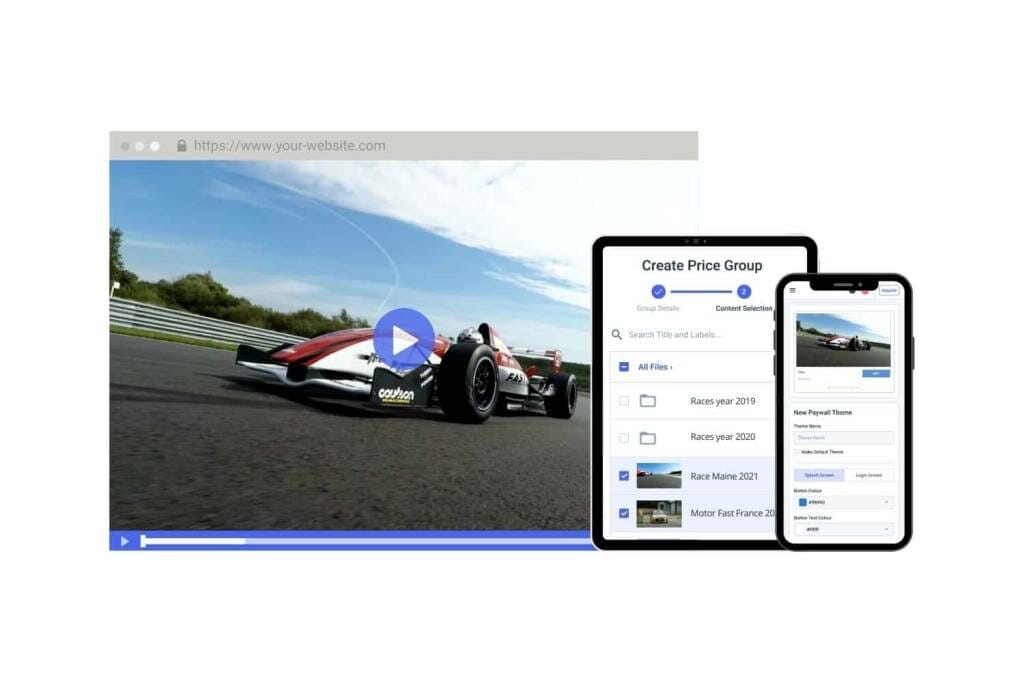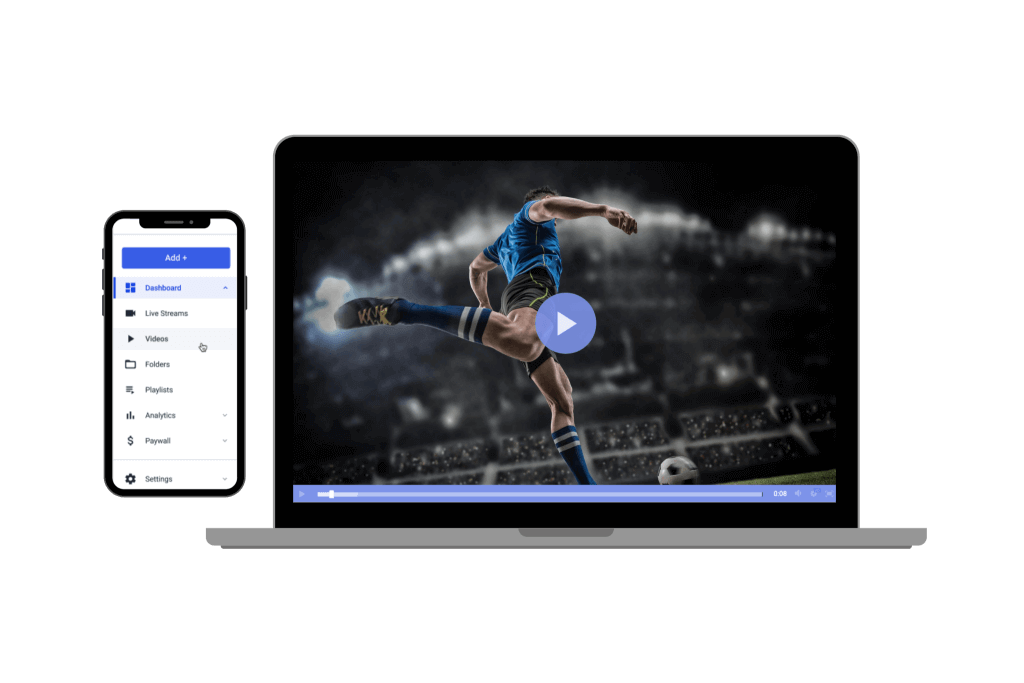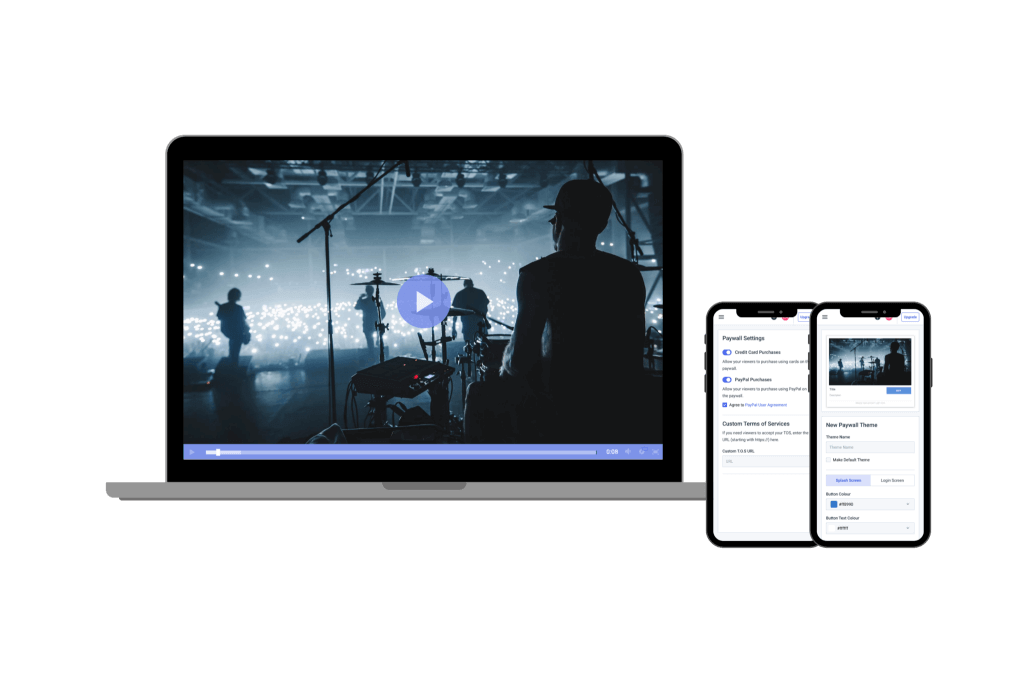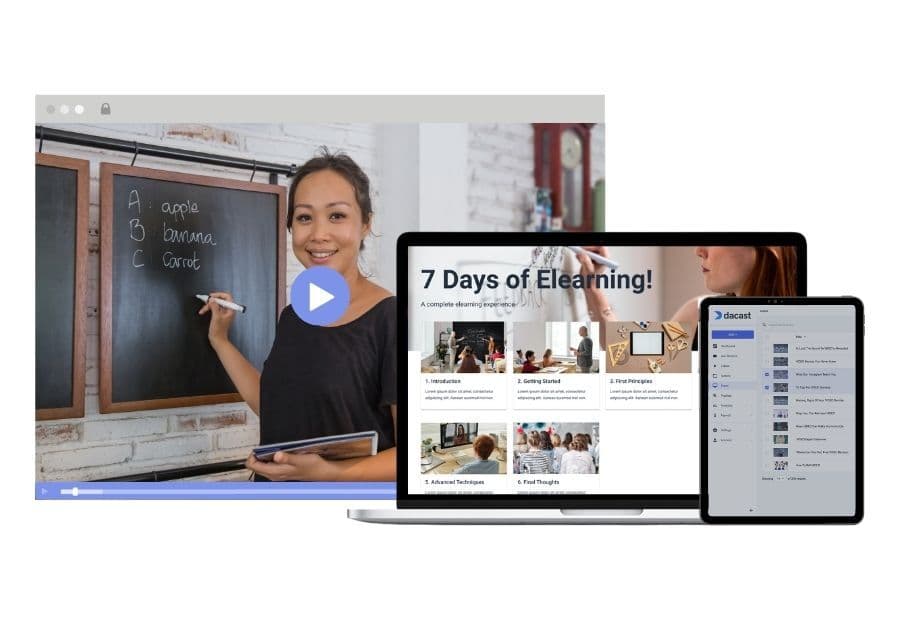How to Make Money Streaming: 14 Ways to Generate Revenue from Online Video in 2025
Online video streaming is becoming the most popular way of delivering content, giving broadcasters various opportunities for live stream monetization. Also, many businesses are tapping into the medium as a revenue source and are looking to generate income from video streaming to cover production costs.
In this post, we’ll discuss how to make money from streaming content and cover the basics of earning through live broadcasts. We’ll look into the expenses broadcasters can expect and overview the top 14 ways to generate revenue from online video streaming.
Table of Contents
- What Is Video Monetization
- Costs Associated with Online Video Streaming
- 14 Ways to Make Money From Live Video Streaming in 2025
- FAQs
- Final Thoughts
What is Video Monetization?

Video monetization refers to generating revenue from video content, which can be done in many different ways. It may involve paid subscriptions on streaming platforms or streaming sponsorship deals.
The three main types of video monetization strategies for streamers include subscriptions:
- (SVOD) or Subscription video on demand
- (AVOD) or Ad-supported video on demand
- Pay-per-view (TVOD or PPV)
All 3 of these monetization models also apply to OTT. You can use use them in various ways.
Video monetization requires the support of a dedicated online video platform combined with one or more video monetization strategies. Dacast, for example, supports all three.
To take it a step further, Dacast has a built-in paywall known for its security. It has auto-conversions for many currencies, making it ideal for broadcasters with international audiences.
Costs Associated with Online Video Streaming
Before we get into methods of earning with live video platforms, it is important to discuss the costs associated with online video streaming. This will help you keep tabs on your expenses and create a solid video monetization strategy to price your offers appropriately.
Online video streaming comes with various costs, depending on your needs and the scale of your stream. Here are some of the major expenses you can expect.
Cameras and Operators
Cameras are essential for live streaming. When it comes to video equipment, there are a few different routes you can go.
At the cheaper end of the spectrum, you can live stream with a $50 webcam or your cell phone. Unfortunately, going cheap may require broadcasters to sacrifice the video quality.
As a middle ground, you could use a dedicated HD camcorder or 4K DSLR. This could range from a couple hundred to a four-digit sum, and is about as simple as you should go to achieve good-quality live streams.
For premium live content, renting a production-quality video camera for a day-long event can easily cost $500 to $2500 or more, depending on various factors. Rentals may also come with an operator, increasing the costs.
To get on the right track, check out our dedicated post on choosing the best live streaming camera.
For more complex, long-term operations, hire a dedicated production team. The cost will depend on the number of people you need and whether the engagement is part-time or full-time.
Switching Hardware or Software
When streaming with multiple sources, you’ll need the support of a switcher to keep things seamless. This is applicable for streaming with different camera feeds, microphones, slides, and other media during your event.
You can use either a hardware or software switcher. Software switchers are typically reasonably priced, but hardware switchers can be expensive, ranging from about $200 to over $1200.
If you opt for a software switcher, you’ll also need a powerful laptop. This is the preferred option for many beginner broadcasters because it gives you the opportunity to get familiar with the process without making too much of an investment while ensuring your live stream income.
It’s also possible to rent this equipment and hire an operator, with a cost similar to that of an additional camera operator.
Bandwidth
Depending on how many viewers you expect, your bandwidth needs will vary. For example, 1000 viewers tuning in for one hour to a stream broadcasting at 1,000 kbps will consume about 500 GB of bandwidth.
Knowing how much bandwidth you’ll use requires a good understanding of the technical side of streaming, including video bitrate, latency, H.264 video encoding, single vs. multi-bitrate encoding workflows, and delivery to various client devices.
Luckily, Dacast’s streaming platform handles all of this and provides an intelligent bandwidth calculator. With this being taken care of, you can focus on your stream and the platform monetization options.
Dacast offers some of the most competitive pricing in the live streaming business, with a 2.4 TB annual allotment of bandwidth starting at $39 per month and a 24 TB annual allotment of bandwidth for $165 per month. These prices decline if you pay for a yearly subscription.
Post Production, Editing, and Technical Support
Additional costs can include post-production and editing to package your video for distribution after the event. It can easily cost hundreds or thousands of dollars, depending on the length of your recording and the complexity of the edits required.
If your monetized video content requires complex tasks like animation and compositing, it will add to the overall cost.
Online Video Hosting
Online video hosting is another expense to consider. Hosting on Dacast starts at $39/month, but more advanced streaming operations can range up to hundreds of dollars a month.
It is important to note that Dacast supports both live and on-demand video hosting on every plan. Other professional hosting providers online include live streaming with more expensive plans.
14 Ways to Make Money From Live Video Streaming

The beauty of online video is that there is so much room for flexibility and creativity, creating many different opportunities for earning with live video platforms.
Let’s look at the top 14 monetization strategies for streamers in 2024.
1. On-Demand Pay-Per-View
A simple way to increase video content creator earnings is to sell access to pre-recorded content via pay-per-view streaming. This approach works well for exclusive or premium videos that audiences are willing to purchase.
Many popular streaming platforms offering on-demand pay-per-view, such as Prime Video or iTunes, allow viewers to buy or rent videos. You can use either of these models, but typically, short-term rentals are available for a couple of dollars less than purchases for unlimited access.
How much you charge will depend on the type of video you have to offer.
2. Insert Advertisements
The traditional way to create ad revenue from streaming is by inserting advertisements into the stream. This method has been used in television and radio for years, and is a popular way of advertising on YouTube.
Video ads for live streams may be inserted before or during your stream, and instead of your audience paying for content, they allow sponsors to access your viewers. Typically, broadcasters will work with an ad network to partner with sponsors with a similar target audience.
Broadcasters can add in-stream advertisements with the online video platform’s ad integration tools. Dacast uses player API, while other live streaming providers offer different options.
3. Live Pay-Per-View Access

Charging viewers a simple pay-per-view hosting fee for accessing your live stream is another straightforward method of how to get paid from streaming. It’s particularly effective for content with high immediate demand. You can set a one-time fee to access your live event, such as a webinar, concert, or sports broadcast. Think of this as a “ticket” or “admission” to your virtual event.
If you live stream pay-per-view via Dacast, setting a price for your live stream and collecting payments via a video paywall from viewers right in the player window is simple.
4. Sponsorship from Businesses
Similar to ad insertion, broadcasters can create partnerships with sponsors to promote their brands, products, and services in a more organic way. As your channel grows, brands will be interested in partnering with you and requesting sponsored content. This affiliate marketing for streamers can involve integrating a brand’s product naturally into the content or dedicating streams to a specific promotion.
Finding businesses willing to sponsor your event, entering into brand deals for streamers, and selling digital products through live streams is especially effective if your content targets a specific location, industry, or niche.
5. Live Shopping
Live shopping is a popular way of live streaming monetization, combining entertainment and commerce into an interactive live shopping experience. One platform that directly supports live shopping is YouTube. It focuses on the Asian market but provides all streamers with tools for referencing the featured products.
Streaming live shopping events allows you to engage directly with your audience, driving immediate sales through direct links, special promotions, and live chat features. Your viewers can ask questions and see the products in action, further engaging them with your content. You’ll earn a commission on sales while building a deeper connection with the audience, which makes live shopping an excellent way of earning through live broadcasts.
6. Merchandise Sales
Streaming merchandise sales is a widespread way of streaming monetization. Capitalize on your loyal audience by selling your branded merchandise, such as T-shirts, mugs, or digital products like eBooks and courses. Promoting your merchandise during live streams and on your social media channels promotes your brand increasing both engagement and sales.
7. Donations and Tips
Donations and tips are one of the most direct and accessible ways to make money from streaming. Streamers often set up donation links or use platform features that allow viewers to contribute funds and make virtual tipping for streamers as a gesture of appreciation. Dedicated viewers or those who liked the specific content can support your work through donations. Platforms like Twitch facilitate this, enabling viewer donations in live streams. You can further increase the fan donations in live video by offering shoutouts or personalized messages for contributors.
8. Ongoing Subscriptions for Access to Content
An alternative to one-time pay-per-view access to your content is selling a video-on-demand subscription to ongoing content. Subscription-based streaming is only effective for those producing and broadcasting content on a regular basis, but it can bring in steady cash flow.
Implement recurring fees granting subscribers access to exclusive content, early releases, or ad-free viewing. Dacast supports such models, enabling steady income streams. Typically, subscriptions are monthly, quarterly, or annually. Netflix, HBO Max, and Disney+ all use this method.
9. Event Access

If you are hosting a virtual event, like a concert, a workshop, or a special live Q&A, you can use a twist on the pay-per-view method and make money streaming. You can charge a flat fee for attendance at the event in real-time. In addition to access to the live streaming event, you can provide a recording of the event for participants to revisit on-demand at a later time.
10. Rebroadcast the Sessions Live
When you’ve put much time, energy, and resources into a single live event, it can be a letdown when the original broadcast doesn’t meet all your goals.
One way to leverage your existing content is to rebroadcast it live, not on-demand, and repeatedly receive donations during live streams. Air the stream during a single access window as if the event were happening live once again. This can be a good method to generate buzz and drive more sales without putting on a new event.
11. Offer Discounts and Promotions
As usual, promotions and discounts through live video sponsorships can drive more sales than would otherwise take place. Dacast or other live streaming providers allow you to generate coupon codes with customized rebates that can be redeemed as often or as rarely as you’d like.
12. Sell Permission to Syndicate Content
Don’t settle for distributing your content on only one channel or website; instead, create streaming platform partnerships.
A great way to generate further revenue is to negotiate deals with partner businesses and organizations whereby you receive a licensing fee, and they receive the right to broadcast your live stream. You can sell rights for simulcasting or on-demand syndication.
13. Sell Recorded Content to Other Broadcasters

An alternative to syndicating live content is selling the on-demand recordings of previously broadcast content to other distributors. Again, this can be an effective revenue generator, as many TV stations, radio stations, and other media distributors are always on the lookout for material to broadcast.
14. Offer Group Pricing to Organizations
Offer group discounts to those who purchase institutional or group subscriptions, video rentals or purchases, or pay-per-view subscriptions to your video content.
Depending on your audience, you may be able to reach large institutions, such as schools, churches, non-profits, businesses, universities, or agencies, in this manner and boost sales.
FAQs
1. How can I use affiliate marketing to monetize my live streams?
Affiliate marketing involves promoting products or services during your live streams and earning a commission on sales generated through your referral links. To implement this, join affiliate programs related to your content niche, incorporate product mentions naturally into your streams, and provide viewers with your unique affiliate links. This strategy allows you to earn passive income as your audience engages with the products you recommend.
2. What role does merchandise sales play in generating revenue from streaming?
Selling merchandise allows you to monetize your brand by offering products like apparel, accessories, or digital goods that resonate with your audience. By creating unique merchandise, you not only generate additional income but also strengthen your community as fans purchase items to show their support. Integrating merchandise stores into your streaming platform can streamline the purchasing process for your viewers.
3. How can I leverage crowdfunding platforms to support my streaming career?
Crowdfunding platforms like Patreon enable viewers to support your content through monthly subscriptions or one-time contributions. In return, you can offer exclusive perks such as behind-the-scenes content, early access to videos, or personalized shout-outs. This model fosters a sense of community and provides a steady income stream, allowing you to focus more on content creation.
4. Can live streaming on multiple platforms increase my earning potential?
Yes, multistreaming to platforms like Twitch, YouTube, and Facebook simultaneously can broaden your reach and diversify your revenue streams. Each platform offers unique monetization features, and by tapping into different audiences, you increase your chances of higher viewership and earnings. However, it’s essential to tailor your content to fit each platform’s culture and guidelines to maximize engagement.
5. How do platform-specific programs enhance monetization for streamers?
Many streaming platforms offer programs that provide additional revenue opportunities. For instance, Twitch’s Partner and Affiliate programs allow streamers to earn through subscriptions, ads, and Bits. Similarly, YouTube’s Partner Program enables monetization via ads, channel memberships, and Super Chats. Participating in these programs can significantly boost your income, provided you meet the eligibility criteria.
6. What are the benefits of securing sponsorships for my live streams?
Sponsorships involve partnering with brands that align with your content, providing you with financial support or free products in exchange for promotion. These collaborations can be lucrative and add credibility to your channel. To attract sponsors, maintain a professional brand image, engage actively with your audience, and showcase your influence within your niche.
Final Thoughts
There are many ways to make money streaming. Sponsored content for streamers, ad revenue, and pay-per-view events are just a few examples of how broadcasters can turn their streams into a profitable business.
Still, most of these strategies require the support of a comprehensive online video platform with dedicated monetization tools.
Are you looking for an online video platform to host your video content? Why not give Dacast a try? Our platform supports all major monetization methods, a secure paywall, group pricing, M3U8 links, and more.
Take advantage of our 14-day risk-free trial to test out our monetization tools for yourself. All you have to do to get started is create a Dacast account today. No credit card is required.
For more tips on live streaming and exclusive offers, be sure to join our LinkedIn group as well.
 Stream
Stream Connect
Connect Manage
Manage Measure
Measure Events
Events Business
Business Organizations
Organizations Entertainment and Media
Entertainment and Media API
API Tools
Tools Learning Center
Learning Center Support
Support Support Articles
Support Articles